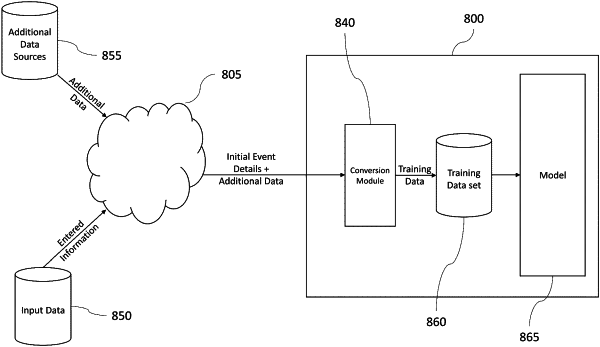| CPC G16H 10/60 (2018.01) [G06N 20/00 (2019.01); G16H 40/60 (2018.01)] | 13 Claims |

|
1. A computer system for controlling a patient's access to a medical resource, the system comprising at least one processor configured to:
provide at least one trained machine learning model which has been trained on a first training data set comprising healthcare event associated data, the at least one trained machine learning model having an input for receiving at least one operating data set associated with a particular healthcare event and an output for generating at least one value associated with the particular healthcare event, the at least one operating data set being obtained from a set of data items associated with the particular healthcare event, the set of data items including data items comprising:
patient-level clinical data; and
temporal data containing time-dependent data regarding the particular healthcare event and describing a state of healthcare facilities and/or external systems at a given point in time,
wherein:
the data items include data accessed from a data store; and
the temporal data accessed from the data store comprises a first indication of availability of healthcare resources;
generate the at least one operating data set in dependence upon the data accessed from the data store;
provide the at least one operating data set to the at least one trained model and receive the at least one value, the at least one value comprising:
a second indication of the availability of the healthcare resources;
generate, based on the at least one value, a first treatment recommendation of the medical resource for assignment to the patient;
in dependence upon the first treatment recommendation, generate an initial indication of an assignment of the medical resource for the patient associated with the particular healthcare event;
subsequent to assigning the medical resource for the patient, receive an indication of an outcome of the treatment recommendation for the patient;
generate a further operating data set that comprises the at least one operating data set and the outcome of the treatment recommendation; and
provide the further operating data set to a further trained machine learning model to generate a second indication of an assignment of the medical resource,
wherein the initial indication of the assignment of the medical resource comprises a test to be carried out on the patient and wherein the further operating data set comprises the first operating data set augmented by including a score derived from the results of the test; and
wherein the first training data set comprises an array, the array including:
a plurality of rows; and
a plurality of columns,
wherein each intersection between one row of the plurality of rows and one column of the plurality of columns contains a feature score, the feature score being associated with:
one healthcare event of a plurality of healthcare events; and
one feature of a plurality of features associated with the plurality of healthcare events or one label of a plurality of labels associated with the plurality of healthcare events.
|